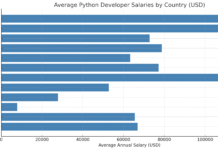Key Takeaways
- Commercial loan software automates lending workflows, improving efficiency, risk assessment, and compliance for financial institutions.
- Key features include AI-driven underwriting, cloud accessibility, and real-time analytics, enabling faster loan approvals and secure transactions.
- Adopting commercial loan software enhances operational efficiency, reduces manual errors, and delivers a seamless digital lending experience.
In today’s fast-paced financial landscape, lenders and financial institutions are constantly seeking innovative solutions to streamline loan management, enhance risk assessment, and improve customer experience. One of the most significant advancements in digital lending technology is commercial loan software—a specialized solution designed to automate and optimize the loan origination, underwriting, servicing, and compliance processes. This technology plays a critical role in modern banking and financial services, enabling institutions to process loans more efficiently while minimizing risks and ensuring regulatory compliance.

With the increasing complexity of commercial lending, traditional loan management methods that rely on manual processes, spreadsheets, and disconnected systems are no longer sufficient. Financial institutions require advanced digital solutions that provide real-time data insights, automated workflows, and seamless integrations with financial ecosystems. Commercial loan software addresses these challenges by offering a centralized platform that enhances operational efficiency, reduces human error, and accelerates loan processing.
As businesses grow and require capital to finance expansions, equipment purchases, or working capital needs, lenders must evaluate loan applications with precision and speed. However, assessing a borrower’s financial health, conducting risk analysis, and ensuring compliance with regulatory frameworks can be time-consuming and resource-intensive when done manually. Commercial loan software leverages artificial intelligence (AI), machine learning (ML), and big data analytics to streamline these processes, providing lenders with robust tools to make informed lending decisions.
Moreover, the rise of fintech innovations and digital banking has transformed how loans are processed and managed. Many financial institutions are now adopting cloud-based commercial loan software solutions, which offer scalability, remote access, and real-time monitoring capabilities. These solutions enable banks, credit unions, and alternative lenders to cater to a diverse range of borrowers, from small businesses to large corporations, with greater efficiency and accuracy.
This article explores the fundamentals of commercial loan software, including its core functionalities, key benefits, and how it works within the lending ecosystem. By understanding the impact of digital lending solutions, financial institutions can leverage cutting-edge technology to enhance their lending operations, drive profitability, and improve borrower satisfaction. Whether you are a lender seeking to modernize your loan management process or a business owner looking to understand how commercial loans are processed, this comprehensive guide will provide valuable insights into the role and workings of commercial loan software.
Before we venture further into this article, we would like to share who we are and what we do.
About 9cv9
9cv9 is a business tech startup based in Singapore and Asia, with a strong presence all over the world.
With over nine years of startup and business experience, and being highly involved in connecting with thousands of companies and startups, the 9cv9 team has listed some important learning points in this overview of What is Commercial Loan Software and How It Works.
If your company needs recruitment and headhunting services to hire top-quality employees, you can use 9cv9 headhunting and recruitment services to hire top talents and candidates. Find out more here, or send over an email to [email protected].
Or just post 1 free job posting here at 9cv9 Hiring Portal in under 10 minutes.
What is Commercial Loan Software and How It Works
- Understanding Commercial Loan Software
- Key Features of Commercial Loan Software
- How Commercial Loan Software Works
- Benefits of Using Commercial Loan Software
- Challenges and Considerations When Implementing Commercial Loan Software
- Future Trends in Commercial Loan Software
1. Understanding Commercial Loan Software
Commercial loan software is a specialized digital solution designed to streamline and automate the loan management process for financial institutions, lenders, and businesses. It facilitates efficient loan origination, underwriting, servicing, and compliance while reducing manual errors and administrative burdens. By integrating advanced technologies such as artificial intelligence (AI), machine learning (ML), and data analytics, commercial loan software helps lenders make informed credit decisions, manage risks effectively, and enhance customer experience.
This section provides an in-depth understanding of commercial loan software, its purpose, key users, and the different types of solutions available in the market.
What is Commercial Loan Software?
Definition and Purpose
- Commercial loan software is a digital platform that automates and manages the end-to-end loan lifecycle, from application submission to loan disbursement and repayment tracking.
- It eliminates the inefficiencies of traditional paper-based loan processing by offering real-time data analysis, automated approvals, and compliance monitoring.
- The software is widely used by banks, credit unions, alternative lenders, and fintech companies to improve operational efficiency and decision-making.
- It ensures regulatory compliance by integrating financial regulations such as Anti-Money Laundering (AML), Know Your Customer (KYC), and Basel III standards.
Key Functions of Commercial Loan Software
- Loan Origination & Application Processing: Automates loan application intake, document collection, and eligibility checks.
- Credit Risk Assessment: Utilizes AI-driven algorithms to assess borrower creditworthiness and minimize default risks.
- Loan Underwriting & Approval: Facilitates quick approval decisions through automated underwriting rules and financial data analysis.
- Loan Servicing & Payment Processing: Manages disbursement, repayment tracking, and interest calculations.
- Regulatory Compliance & Reporting: Ensures adherence to financial regulations through built-in compliance checks and audit trails.
Who Uses Commercial Loan Software?
Commercial loan software is widely adopted by various financial institutions and businesses involved in lending activities.
1. Banks and Financial Institutions
- Large commercial banks and financial service providers use loan software to manage high-volume loan applications efficiently.
- Example: JPMorgan Chase & Co. leverages digital loan management platforms to handle corporate and small business loans seamlessly.
2. Credit Unions and Cooperative Banks
- Credit unions and cooperative financial institutions use commercial loan software to offer loans at competitive rates while ensuring compliance with financial regulations.
- Example: Navy Federal Credit Union uses digital lending solutions to streamline member loan applications and approval processes.
3. Alternative and Online Lenders
- Fintech companies and peer-to-peer lending platforms rely on AI-powered loan software to offer faster loan approvals and personalized lending options.
- Example: LendingClub and Kabbage use automated loan origination and underwriting software to provide quick and flexible loan solutions to businesses.
4. Private Lenders and Investment Firms
- Private lenders and venture capital firms use commercial loan software to evaluate investment opportunities and manage lending portfolios efficiently.
- Example: BlackRock utilizes digital lending tools to assess borrower risk and manage capital allocation.
5. Businesses and Corporate Borrowers
- Large corporations use commercial loan software to secure business loans, manage financial transactions, and optimize capital flow.
- Example: Tesla Inc. and other large enterprises use business lending platforms to finance infrastructure and expansion projects.
Types of Commercial Loan Software
Different types of commercial loan software solutions cater to the specific needs of financial institutions and businesses.
1. Cloud-Based Commercial Loan Software
- Hosted on cloud servers, offering remote access and scalability.
- Provides real-time data synchronization and secure cloud storage.
- Example: nCino, a cloud-based lending platform used by financial institutions for loan origination and management.
2. On-Premise Commercial Loan Software
- Installed on local servers, giving financial institutions full control over security and customization.
- Best suited for large banks with strict data security policies.
- Example: FIS Commercial Lending Suite, an enterprise-level on-premise solution for complex loan management.
3. AI-Powered Loan Management Software
- Uses machine learning algorithms to automate risk assessment and loan approvals.
- Helps lenders detect fraudulent activities and predict borrower default risks.
- Example: Zest AI, a lending platform that leverages AI to enhance credit risk decision-making.
4. Industry-Specific Commercial Loan Software
- Tailored for specific industries such as real estate, healthcare, agriculture, and manufacturing.
- Example: RealAtom, a lending platform designed for commercial real estate loans.
Key Benefits of Commercial Loan Software
1. Faster Loan Processing and Approvals
- Automates tedious tasks such as document verification, credit assessment, and underwriting.
- Reduces approval times from weeks to days, or even hours, depending on the software capabilities.
2. Improved Risk Management and Credit Assessment
- AI-powered risk assessment models analyze borrower data to minimize bad loans.
- Real-time fraud detection mechanisms help prevent financial losses.
3. Enhanced Compliance and Regulatory Adherence
- Ensures compliance with international and local financial regulations.
- Reduces penalties and legal risks associated with improper lending practices.
4. Cost Savings and Operational Efficiency
- Minimizes administrative costs by reducing manual labor and paper-based processes.
- Allows lenders to allocate resources efficiently and focus on customer engagement.
5. Better Customer Experience
- Provides borrowers with digital self-service options, allowing them to apply for loans online.
- Enhances communication through automated notifications and real-time loan status updates.
Conclusion
Understanding commercial loan software is essential for financial institutions and lenders looking to enhance their loan management, risk assessment, and customer experience. By leveraging advanced digital solutions, financial organizations can improve efficiency, ensure compliance, and optimize lending operations. Whether it is a bank, credit union, fintech company, or private lender, the right commercial loan software can drive profitability and enhance lending strategies.
As financial technology continues to evolve, adopting AI-driven, cloud-based, and data-integrated loan solutionswill be crucial for staying competitive in the modern lending landscape.
2. Key Features of Commercial Loan Software
Commercial loan software is designed to enhance the efficiency and accuracy of loan origination, underwriting, servicing, and compliance processes. It offers a range of advanced features that help lenders manage their loan portfolios, assess risks, and provide a seamless experience to borrowers. From AI-driven credit analysis to automated document management, these features play a critical role in modernizing the lending landscape.
This section explores the key features of commercial loan software, detailing how they improve financial institutions’ operations and decision-making capabilities.
1. Automated Loan Origination and Application Processing
Efficient loan origination is crucial for banks and lenders to process applications quickly and accurately. Commercial loan software automates this process, reducing manual effort and errors.
Key Functionalities:
- Online Loan Application Portals: Enables borrowers to submit applications digitally via web or mobile platforms.
- Pre-screening and Eligibility Checks: Uses AI algorithms to verify applicant details and assess basic eligibility before moving to underwriting.
- Document Collection and Management: Automates document uploads, verification, and classification for streamlined processing.
- Credit Score and Risk Assessment Integration: Connects with credit bureaus such as Experian, Equifax, and TransUnion for instant borrower credit score retrieval.
- Automated Approval and Rejection Criteria: Uses predefined rules to approve or reject applications based on financial risk and compliance factors.
Example:
- LendingClub uses automated loan origination software to process thousands of loan applications daily, reducing approval times and enhancing customer satisfaction.
2. AI-Powered Credit Risk Analysis and Scoring
Lenders need to assess a borrower’s financial health and predict the likelihood of loan default. AI-powered credit risk assessment tools provide real-time insights based on multiple financial data points.
Key Functionalities:
- AI-Driven Risk Assessment Models: Uses machine learning to analyze past repayment behavior, industry risks, and financial patterns.
- Alternative Credit Scoring: Incorporates non-traditional data, such as transaction history, social media activity, and cash flow analysis.
- Fraud Detection and Prevention: Identifies suspicious loan applications and flags potential fraud risks.
- Predictive Default Analysis: Uses big data analytics to forecast potential loan defaults and mitigate risk exposure.
Example:
- Zest AI provides AI-driven credit underwriting models that help lenders assess borrowers beyond traditional credit scores, improving financial inclusion.
3. Loan Underwriting and Decision Automation
Underwriting is one of the most critical steps in commercial lending. Loan software automates underwriting processes to ensure faster and more data-driven decision-making.
Key Functionalities:
- Automated Financial Analysis: Analyzes borrower financial statements, tax returns, and cash flow projections.
- Customizable Underwriting Rules: Allows lenders to configure risk thresholds, interest rates, and eligibility criteria.
- Debt-to-Income Ratio (DTI) and Loan-to-Value (LTV) Calculations: Provides real-time financial metrics to assess loan affordability.
- Integration with External Financial Data Providers: Connects with third-party financial institutions for real-time verification of assets, liabilities, and income.
- Approval Workflow Automation: Streamlines approval hierarchies based on predefined conditions, reducing processing time.
Example:
- Encompass by ICE Mortgage Technology provides automated underwriting solutions that help lenders quickly approve loans with real-time credit and income analysis.
4. Loan Servicing and Payment Management
Loan servicing software ensures that repayment schedules, interest calculations, and loan account management run smoothly for both lenders and borrowers.
Key Functionalities:
- Automated Payment Scheduling: Sets up and processes recurring payments for interest and principal amounts.
- Multi-Currency and Multi-Language Support: Helps international lenders manage loans across different regions.
- Real-Time Loan Balance and Amortization Tracking: Keeps lenders and borrowers updated on outstanding balances and interest accruals.
- Integration with Accounting Software: Syncs with QuickBooks, Xero, and SAP for seamless financial reporting.
- Customizable Payment Structures: Supports different repayment plans such as fixed-rate, variable-rate, interest-only, and balloon payments.
Example:
- nCino’s Commercial Loan Management System automates loan servicing tasks, helping banks manage loan repayments more efficiently.
5. Compliance Management and Regulatory Reporting
Regulatory compliance is crucial for financial institutions. Commercial loan software ensures adherence to local and international financial regulations.
Key Functionalities:
- Built-in Compliance Checks: Automatically verifies loans against regulatory frameworks like Basel III, Anti-Money Laundering (AML), and Know Your Customer (KYC).
- Audit Trail and Document Tracking: Maintains a secure log of all financial transactions and approvals for compliance audits.
- Automated Reporting Tools: Generates financial reports for regulators such as the Federal Reserve, FDIC, and SEC.
- GDPR and Data Privacy Compliance: Ensures borrower data security and privacy in accordance with global regulations.
Example:
- Fiserv’s Loan Management Platform provides automated compliance monitoring tools that help banks adhere to global financial regulations.
6. Cloud-Based and Mobile Accessibility
Cloud-based loan management solutions allow lenders to access loan data from anywhere while ensuring security and real-time collaboration.
Key Functionalities:
- Cloud Hosting for Scalability: Offers on-demand scalability to handle increasing loan volumes.
- Mobile-Friendly Borrower Portals: Enables borrowers to track loan status and make payments via mobile devices.
- Role-Based Access Control: Ensures only authorized personnel can access sensitive loan data.
- Disaster Recovery and Data Backup: Provides automated backup and recovery solutions for business continuity.
Example:
- BankPoint’s Cloud-Based Loan Software allows financial institutions to manage loans remotely with real-time updates.
7. Loan Portfolio Management and Analytics
Lenders require real-time insights to monitor their loan portfolios, assess risks, and optimize lending strategies.
Key Functionalities:
- Portfolio Risk Analysis Dashboards: Offers visual insights into loan performance, default rates, and profitability metrics.
- Loan Performance Monitoring: Tracks delinquent accounts and high-risk borrowers.
- Predictive Analytics for Loan Trends: Helps lenders adjust lending strategies based on market and borrower behavior trends.
- Customizable Reporting and Data Export: Generates custom financial reports and allows seamless data integration with external analytics tools.
Example:
- Moody’s Analytics Lending Suite provides AI-driven insights into commercial loan portfolio performance, helping banks mitigate financial risks.
8. Third-Party Integrations and API Connectivity
Seamless integration with third-party services enhances loan management software’s functionality and flexibility.
Key Functionalities:
- Credit Bureau API Integration: Connects with Experian, Equifax, and TransUnion for instant credit reports.
- Bank Account Verification Services: Links with financial institutions to verify borrower assets and transactions.
- Accounting and ERP System Integration: Syncs with financial management tools like Oracle NetSuite, QuickBooks, and SAP.
- E-Signature and Document Management: Integrates with DocuSign and Adobe Sign for digital document processing.
Example:
- Blend’s Loan Origination System integrates with multiple financial platforms, enabling seamless data exchange and credit analysis.
Conclusion
The key features of commercial loan software play a vital role in enhancing loan processing efficiency, risk management, and borrower experience. From AI-driven credit assessments to cloud-based accessibility and compliance monitoring, these features enable lenders to make informed lending decisions while optimizing operational workflows.
With continuous advancements in AI, automation, and financial technology, commercial loan software will continue evolving to meet the demands of a dynamic lending market. Financial institutions that adopt these innovative digital solutions can gain a competitive edge, improve customer satisfaction, and enhance profitability in the ever-changing commercial lending landscape.
3. How Commercial Loan Software Works
Commercial loan software streamlines the entire loan lifecycle, from application and underwriting to servicing and compliance. By automating key processes, integrating data from various sources, and leveraging AI-driven analytics, this software ensures efficiency, accuracy, and regulatory compliance.
This section provides a detailed breakdown of how commercial loan software works, covering each stage of the loan management process with relevant functionalities and examples.
1. Loan Origination and Application Processing
The loan origination phase involves collecting borrower information, verifying eligibility, and assessing initial creditworthiness.
Key Steps:
- Digital Loan Application:
- Borrowers apply online via a web or mobile platform.
- AI-driven chatbots assist applicants in filling out forms.
- Document Submission and Verification:
- Applicants upload financial statements, tax returns, and business incorporation documents.
- Optical Character Recognition (OCR) scans and verifies documents automatically.
- Pre-qualification Screening:
- The software cross-checks borrower data with eligibility criteria.
- Automated risk assessment identifies high-risk applicants.
- Credit Score Retrieval:
- Integrates with credit bureaus like Experian, Equifax, and TransUnion for instant score checks.
Example:
- Blend’s Loan Origination System enables banks to process loan applications digitally, reducing manual intervention and improving efficiency.
2. Credit Risk Assessment and Underwriting
Commercial loan software uses AI-powered models to analyze borrower risk and determine loan eligibility.
Key Steps:
- Financial Health Analysis:
- The system examines cash flow, debt-to-income ratio (DTI), loan-to-value (LTV), and financial statements.
- Automated Credit Decisioning:
- AI-driven models predict borrower risk based on historical data.
- Alternative data sources like transaction history and industry performance are considered.
- Debt Service Coverage Ratio (DSCR) Calculation:
- Determines the borrower’s ability to repay the loan based on net operating income and total debt service.
- Fraud Detection:
- Machine learning algorithms detect fraudulent applications based on inconsistencies in financial data.
Example:
- Zest AI’s Credit Underwriting System uses machine learning to improve risk predictions and credit decisioning accuracy.
3. Loan Approval and Offer Generation
Once a borrower is deemed eligible, the system generates loan terms and offers.
Key Steps:
- Interest Rate Calculation:
- The system considers market trends, borrower risk, and lender policies to determine interest rates.
- Loan Term and Repayment Structure Selection:
- Lenders customize loan duration, repayment schedules, and collateral requirements.
- E-Signature and Agreement Processing:
- Loan agreements are auto-generated and sent for digital signature via DocuSign or Adobe Sign.
Example:
- Encompass by ICE Mortgage Technology enables instant loan offer generation with automated document signing.
4. Loan Disbursement and Fund Transfer
After approval, funds are transferred to the borrower’s account.
Key Steps:
- Bank Account Verification:
- The system validates borrower account details before fund transfer.
- Automated Disbursement Workflow:
- Integrates with SWIFT, ACH, and wire transfer networks for direct fund deposits.
- Payment Scheduling and Loan Setup:
- The software configures interest rates, repayment schedules, and auto-deductions.
Example:
- Fiserv’s Loan Management Platform streamlines disbursement by integrating with banking networks.
5. Loan Servicing and Payment Management
Loan servicing involves tracking payments, managing interest calculations, and handling delinquencies.
Key Steps:
- Automated Payment Processing:
- Borrowers set up auto-debit payments via bank transfers, credit cards, or digital wallets.
- Real-time Loan Balance and Interest Calculation:
- The system updates outstanding balances and amortization schedules.
- Late Payment Tracking and Penalty Calculation:
- Flags overdue payments and applies late fees.
- Loan Modification and Refinancing:
- Supports adjustments in interest rates, loan extensions, and restructuring.
Example:
- nCino’s Loan Servicing Software automates payment collections and interest tracking for commercial loans.
6. Compliance and Regulatory Reporting
Commercial loan software ensures lenders comply with financial regulations.
Key Steps:
- Automated Compliance Checks:
- Verifies compliance with AML (Anti-Money Laundering), KYC (Know Your Customer), Basel III, and GDPR.
- Audit Trail and Transaction Monitoring:
- Logs every transaction for audit purposes.
- Regulatory Reporting Automation:
- Generates reports for SEC, FDIC, and financial auditors.
Example:
- Moody’s Analytics Regulatory Compliance Tools automate risk assessment and compliance reporting.
7. Loan Portfolio Monitoring and Risk Management
Lenders use real-time analytics to track loan performance and mitigate risks.
Key Steps:
- Portfolio Performance Analysis:
- Dashboards display loan status, default rates, and profitability.
- Predictive Risk Modeling:
- AI forecasts market trends and borrower repayment behavior.
- Early Delinquency Warnings:
- Identifies loans at risk of default and triggers alerts for proactive measures.
Example:
- Lendio’s Business Loan Analytics uses AI to monitor loan health and flag risks.
8. Integration with Third-Party Financial Systems
To enhance efficiency, commercial loan software integrates with other financial tools.
Key Steps:
- Banking and Payment System Integration:
- Connects with SWIFT, PayPal, and Stripe for seamless transactions.
- ERP and Accounting Software Syncing:
- Links with QuickBooks, SAP, and Oracle NetSuite for financial reporting.
- Credit Bureau and Risk Assessment APIs:
- Retrieves real-time credit scores and borrower risk reports.
Example:
- BankPoint’s Loan Management API integrates with multiple banking systems for a seamless workflow.
Conclusion
Commercial loan software revolutionizes the lending industry by automating critical processes, ensuring compliance, and optimizing risk assessment. With AI-driven credit analysis, automated underwriting, seamless loan servicing, and regulatory adherence, these platforms enhance efficiency and profitability for financial institutions.
As lending technology continues to evolve, adopting cloud-based, AI-powered loan management systems will be key to staying competitive in the fast-changing financial landscape.
4. Benefits of Using Commercial Loan Software
Commercial loan software has transformed the lending industry by enhancing efficiency, improving risk assessment, ensuring regulatory compliance, and streamlining the entire loan lifecycle. With automation, AI-driven analytics, and cloud-based functionalities, lenders can process loans faster, reduce operational costs, and provide a seamless borrowing experience.
This section explores the key benefits of commercial loan software, detailing how financial institutions, lenders, and borrowers gain from its advanced capabilities.
1. Enhanced Efficiency and Faster Loan Processing
Automating loan management reduces manual workload, enabling lenders to process applications more quickly and accurately.
Key Advantages:
- Automated Loan Origination:
- Borrowers submit loan applications digitally, reducing paperwork.
- AI-driven chatbots assist applicants in real time.
- Instant Document Verification:
- Optical Character Recognition (OCR) extracts and verifies borrower details from financial documents.
- Reduces manual data entry errors and speeds up approval timelines.
- Pre-qualification and Automated Credit Decisioning:
- AI models analyze creditworthiness instantly, minimizing human intervention.
- Example:
- nCino’s Cloud Banking Platform automates the entire loan approval process, reducing processing time by up to 60%.
2. Improved Accuracy and Reduced Errors
Manual loan processing is prone to errors, miscalculations, and inconsistencies. Commercial loan software ensures accuracy in financial assessments.
Key Advantages:
- Automated Risk Assessment:
- AI algorithms evaluate borrower credit scores, financial health, and risk factors with precision.
- Error-Free Loan Calculations:
- Auto-generated interest calculations, repayment schedules, and penalty computations eliminate miscalculations.
- Integrated Data Validation:
- Ensures consistency across loan applications, financial statements, and regulatory reports.
- Example:
- Fiserv’s Loan Management System minimizes calculation errors by automating interest rate adjustments and amortization schedules.
3. Enhanced Risk Management and Credit Assessment
Lenders need to assess borrower risk accurately to prevent loan defaults and financial losses.
Key Advantages:
- AI-Driven Predictive Analytics:
- Forecasts borrower behavior based on historical loan data.
- Helps lenders make data-driven lending decisions.
- Automated Fraud Detection:
- Machine learning identifies fraudulent applications by detecting irregular patterns in financial data.
- Real-time Portfolio Monitoring:
- Tracks loan performance, highlights potential defaults, and enables proactive risk mitigation.
- Example:
- Zest AI’s Credit Underwriting Tool enhances risk assessment by analyzing alternative credit data.
4. Better Regulatory Compliance and Audit Readiness
Financial institutions must adhere to complex regulatory requirements. Commercial loan software automates compliance checks and reporting.
Key Advantages:
- Automated KYC and AML Compliance:
- Verifies borrower identity and flags suspicious transactions.
- Regulatory Reporting Automation:
- Generates reports for Basel III, GDPR, SEC, FDIC, and other regulatory bodies.
- Audit Trail Maintenance:
- Tracks all loan transactions and modifications for audit transparency.
- Example:
- Moody’s Analytics Risk Management Software ensures compliance with global financial regulations.
5. Increased Productivity and Reduced Operational Costs
Automating loan processes reduces staffing needs, saving both time and money.
Key Advantages:
- Faster Application Processing:
- Loan officers can handle a higher volume of applications with automated workflows.
- Reduction in Manual Labor:
- Fewer staff members are required for data entry, underwriting, and compliance checks.
- Cloud-based Accessibility:
- Lenders can manage loans remotely, eliminating the need for extensive physical infrastructure.
- Example:
- Lendio’s Business Loan Platform helps financial institutions increase productivity by automating loan matchmaking and approvals.
6. Improved Customer Experience and Engagement
A seamless loan application and approval process leads to higher borrower satisfaction.
Key Advantages:
- Self-Service Portals for Borrowers:
- Customers can track loan applications, make payments, and request modifications online.
- 24/7 Loan Application Availability:
- Cloud-based systems allow borrowers to apply at any time.
- Faster Approvals and Fund Disbursement:
- Shortened approval timelines lead to quicker loan access.
- Example:
- Blend’s Digital Lending Platform enables a fully digital loan experience, reducing processing times for borrowers.
7. Scalability and Flexibility for Growing Businesses
Commercial loan software accommodates business growth by supporting multiple loan types and expanding functionalities.
Key Advantages:
- Multi-Lender and Multi-Product Support:
- Handles business loans, equipment financing, real estate loans, and more.
- Cloud-Based and API Integration Capabilities:
- Scales operations without infrastructure limitations.
- Customization for Industry-Specific Needs:
- Tailors workflows for banks, credit unions, and alternative lenders.
- Example:
- BankPoint’s Loan Management API allows seamless integration with third-party banking and accounting systems.
8. Stronger Loan Portfolio Performance and Profitability
Optimizing loan servicing and minimizing defaults leads to increased profitability for lenders.
Key Advantages:
- Real-Time Loan Monitoring and Performance Analytics:
- Tracks loan repayment trends and borrower financial health.
- Automated Loan Refinancing and Restructuring:
- Helps borrowers modify loan terms when necessary, reducing defaults.
- Early Delinquency Warnings:
- Identifies loans at risk of default and enables proactive solutions.
- Example:
- LendKey’s Loan Portfolio Management System provides AI-driven risk monitoring and portfolio optimization.
9. Seamless Integration with Banking and Financial Systems
Commercial loan software connects with various financial tools to enhance efficiency.
Key Advantages:
- Integration with Credit Bureaus:
- Retrieves borrower credit scores from Experian, Equifax, and TransUnion.
- Accounting and ERP System Syncing:
- Connects with QuickBooks, SAP, and Oracle NetSuite for financial reporting.
- Automated Payment Processing with Banks and Fintech Platforms:
- Supports ACH transfers, SWIFT payments, and digital wallets.
- Example:
- Finastra’s Lending Platform integrates seamlessly with banking core systems for real-time data synchronization.
Conclusion
Adopting commercial loan software transforms lending operations by enhancing efficiency, improving risk management, ensuring compliance, and boosting profitability. With AI-driven analytics, automation, and cloud-based capabilities, financial institutions can process loans faster, minimize errors, and provide an exceptional borrower experience.
As the lending industry continues to evolve, businesses that leverage advanced loan management software will gain a competitive edge, ensuring long-term growth and sustainability in an increasingly digital financial landscape.
5. Challenges and Considerations When Implementing Commercial Loan Software
While commercial loan software offers numerous advantages, financial institutions and lenders must navigate several challenges when implementing these solutions. From integration complexities to regulatory compliance, businesses must carefully evaluate their needs, address potential risks, and adopt best practices for a smooth transition.
This section explores the key challenges and considerations involved in implementing commercial loan software, providing insights into how organizations can effectively overcome them.
1. Integration with Existing Banking and Financial Systems
Financial institutions often use multiple software solutions for different aspects of loan management, creating integration challenges.
Key Challenges:
- Legacy System Compatibility:
- Many banks and credit unions still rely on outdated legacy systems that may not be compatible with modern loan software.
- Data migration from old systems to new platforms can be complex and time-consuming.
- Multiple Platform Synchronization:
- Loan software must seamlessly integrate with core banking systems, accounting tools, and credit bureaus.
- Inconsistent data formats across platforms can create synchronization issues.
- Example:
- A mid-sized bank implementing nCino’s Cloud Banking Software faced difficulties integrating its legacy customer relationship management (CRM) system, requiring a customized API solution.
Considerations for Overcoming Integration Challenges:
- Choose commercial loan software with robust API capabilities to enable smooth data exchange.
- Conduct a comprehensive IT audit before implementation to identify compatibility issues.
- Work with experienced fintech consultants to streamline integration efforts.
2. Regulatory Compliance and Security Concerns
Lenders must comply with multiple financial regulations while ensuring data security and privacy.
Key Challenges:
- Complex and Evolving Regulations:
- Commercial loan software must comply with Basel III, Dodd-Frank Act, GDPR, and other regional financial regulations.
- Regulatory updates require continuous software modifications, which can be costly.
- Data Privacy and Cybersecurity Risks:
- Loan software stores sensitive borrower data, making it a prime target for cyber threats.
- Financial institutions must implement strict security protocols to prevent data breaches.
- Example:
- A U.S.-based lender using Moody’s Analytics Risk Management Software had to undergo extensive audits to ensure compliance with Consumer Financial Protection Bureau (CFPB) regulations.
Considerations for Ensuring Compliance and Security:
- Select software providers with built-in compliance monitoring and automated reporting tools.
- Implement multi-factor authentication (MFA) and data encryption to enhance security.
- Regularly update security patches and conduct cybersecurity risk assessments.
3. High Implementation Costs and Budget Constraints
Implementing commercial loan software requires a significant financial investment, which may not be feasible for all lenders.
Key Challenges:
- Upfront Software Licensing and Customization Costs:
- Many commercial loan platforms require substantial one-time licensing fees and recurring subscription costs.
- Customization for specific business needs further increases expenses.
- IT Infrastructure and Training Expenses:
- Banks and financial institutions may need to upgrade servers, cloud storage, and cybersecurity frameworks.
- Training employees on new software can lead to productivity slowdowns during the transition.
- Example:
- A regional credit union found that switching to Finastra’s Lending Platform required significant investment in cloud-based IT infrastructure, straining its annual budget.
Considerations for Managing Costs:
- Opt for cloud-based loan software to minimize infrastructure costs.
- Negotiate custom pricing plans with software vendors to align with business needs.
- Implement a phased rollout strategy to spread costs over multiple quarters.
4. User Adoption and Staff Training Challenges
Employees and loan officers may struggle to adapt to new software, reducing efficiency during the transition phase.
Key Challenges:
- Resistance to Change:
- Loan officers accustomed to manual processes may hesitate to adopt automated solutions.
- Steep Learning Curve:
- Advanced AI-driven commercial loan software often requires technical training for employees to use it effectively.
- Time-Intensive Training Requirements:
- Businesses must allocate sufficient time for software onboarding, which can temporarily impact loan processing efficiency.
- Example:
- A private lender implementing Lendio’s Business Loan Platform reported initial productivity losses as employees adjusted to the digital application workflow.
Considerations for Encouraging Adoption:
- Organize hands-on training sessions and provide access to detailed user manuals.
- Appoint software champions within departments to assist colleagues in the transition.
- Utilize AI-driven chatbots and guided tutorials to simplify user onboarding.
5. Customization Limitations and Business-Specific Needs
Not all commercial loan software solutions can meet the unique requirements of different lending institutions.
Key Challenges:
- Limited Customization Options:
- Many off-the-shelf software solutions do not offer industry-specific loan structuring capabilities.
- Inflexibility in Workflow Modifications:
- Businesses with non-standard loan products may struggle to fit their processes into rigid software workflows.
- Example:
- A real estate financing firm found that BankPoint’s Loan Management Software lacked features for complex commercial property financing, requiring additional customization.
Considerations for Choosing the Right Software:
- Select software that supports modular customization and workflow flexibility.
- Ensure the platform allows API integration with third-party services.
- Work with vendors offering tailored development solutions.
6. Data Migration and Accuracy Issues
Transferring loan data from legacy systems to new software can lead to errors and inconsistencies.
Key Challenges:
- Data Loss and Corruption Risks:
- Poorly executed migrations can result in missing or duplicated borrower records.
- Inconsistent Data Formatting:
- Loan data stored in different formats may not align with the new system’s structure.
- Time-Intensive Migration Process:
- Large datasets require careful extraction, validation, and reconfiguration before transfer.
- Example:
- A commercial bank shifting to Zest AI’s Loan Underwriting Platform encountered difficulties converting historical loan risk assessments into the new system.
Considerations for a Smooth Data Migration:
- Conduct pilot testing before full-scale migration.
- Use data validation tools to detect and correct discrepancies.
- Maintain a backup of legacy loan records for reference.
7. Scalability and Future-Proofing Challenges
Lenders must ensure that the software they choose can accommodate future business growth and technological advancements.
Key Challenges:
- Limited Scalability in Some Platforms:
- Some commercial loan software solutions may not support expanding loan portfolios or additional lending products.
- Lack of AI and Automation Upgrades:
- Outdated platforms may not integrate AI-driven analytics, machine learning models, or blockchain technology.
- Example:
- A growing fintech lender using LendKey’s Loan Servicing Software needed to switch providers when the software failed to handle peer-to-peer lending expansion.
Considerations for Future-Proofing Software Investments:
- Choose cloud-based and AI-integrated loan platforms.
- Partner with software vendors that offer continuous innovation and feature updates.
- Ensure the solution supports cross-border lending and multi-currency transactions for global expansion.
Conclusion
Implementing commercial loan software requires careful planning, strategic investments, and proactive risk management. Financial institutions must address integration challenges, ensure compliance, train employees effectively, and select software that aligns with their long-term goals.
By overcoming these challenges, lenders can fully leverage commercial loan software’s potential to enhance efficiency, streamline operations, and deliver superior financial services.
6. Future Trends in Commercial Loan Software
The commercial lending industry is evolving rapidly, driven by advancements in financial technology (FinTech), artificial intelligence (AI), automation, and regulatory changes. Commercial loan software is transforming how financial institutions process loan applications, assess risks, and manage compliance requirements. To stay competitive, lenders must adopt emerging technologies that enhance efficiency, improve customer experiences, and reduce operational costs.
This section explores the future trends in commercial loan software, highlighting innovations that will shape the lending landscape in the coming years.
1. Increased Adoption of Artificial Intelligence (AI) and Machine Learning (ML)
AI and ML are revolutionizing commercial loan software by automating decision-making processes and improving risk assessment.
Key Trends:
- AI-Powered Loan Underwriting:
- AI algorithms analyze borrower creditworthiness more accurately than traditional models.
- AI underwriting reduces manual intervention and speeds up loan approvals.
- Predictive Analytics for Risk Assessment:
- Machine learning models identify potential loan defaults by analyzing historical data.
- Predictive analytics enhance proactive risk mitigation strategies.
- Example:
- Lenders using Zest AI’s Risk Modeling Platform have reported 30% improved loan approval accuracywhile minimizing default risks.
Impact on the Future:
- AI-driven automation will significantly reduce loan processing times.
- Lenders will benefit from real-time risk monitoring and data-driven decision-making.
- More financial institutions will adopt AI chatbots to assist borrowers with loan applications.
2. Expansion of Cloud-Based Commercial Loan Software
Cloud computing is becoming the preferred choice for financial institutions due to its scalability, security, and cost-effectiveness.
Key Trends:
- Migration to Software-as-a-Service (SaaS) Models:
- Lenders are shifting from on-premise to cloud-based loan platforms for better accessibility.
- SaaS-based loan solutions reduce IT infrastructure costs and enable remote access to loan management tools.
- Enhanced Data Security and Compliance:
- Cloud providers offer bank-grade encryption and automated compliance tracking.
- Regular software updates ensure compliance with evolving financial regulations.
- Example:
- Many banks have adopted nCino’s Cloud Banking Software, which provides a fully integrated commercial lending platform accessible from anywhere.
Impact on the Future:
- Cloud adoption will accelerate digital transformation in commercial lending.
- Financial institutions will rely on API-driven cloud ecosystems for seamless data sharing.
- Hybrid cloud solutions will gain popularity, balancing security and flexibility.
3. Blockchain Technology for Secure and Transparent Transactions
Blockchain is poised to revolutionize commercial loan software by ensuring data integrity, transparency, and fraud prevention.
Key Trends:
- Smart Contracts for Loan Agreements:
- Blockchain-powered smart contracts automate loan disbursement and repayment tracking.
- These contracts eliminate intermediaries, reducing administrative costs.
- Decentralized Lending Platforms:
- Peer-to-peer (P2P) commercial lending powered by blockchain enhances lender-borrower trust.
- Secure ledger technology prevents data tampering and enhances regulatory reporting.
- Example:
- JPMorgan’s Quorum Blockchain Platform is being explored for commercial loan settlements with enhanced security.
Impact on the Future:
- Blockchain will reduce loan processing fraud by ensuring data immutability.
- More financial institutions will integrate decentralized finance (DeFi) principles in lending models.
- Regulators may introduce blockchain-based compliance frameworks for transparent loan reporting.
4. Automation and Robotic Process Automation (RPA) in Loan Processing
Automation is reshaping commercial loan workflows by minimizing manual interventions and enhancing accuracy.
Key Trends:
- End-to-End Loan Origination Automation:
- Loan software is integrating RPA bots to automate document verification, credit scoring, and compliance checks.
- AI-driven optical character recognition (OCR) extracts data from financial statements and tax returns.
- Faster Loan Approvals and Disbursements:
- Automated systems process loan applications within minutes rather than days.
- AI-powered risk analysis enhances real-time decision-making.
- Example:
- Lendio’s AI-Powered Lending Platform has reduced manual data entry by 80%, significantly accelerating loan approvals.
Impact on the Future:
- Automation will eliminate repetitive loan processing tasks, improving efficiency.
- Financial institutions will require fewer human resources for routine loan assessments.
- Loan origination platforms will offer self-service portals for borrowers, enhancing customer experiences.
5. Embedded Finance and API-Driven Lending Solutions
Lending services are being integrated into third-party platforms through APIs, enabling seamless financial transactions.
Key Trends:
- Banking-as-a-Service (BaaS) Models:
- Commercial lenders are embedding loan services into e-commerce, ERP, and payment platforms.
- Businesses can access financing options directly through accounting software or payroll platforms.
- Open Banking APIs for Loan Approvals:
- APIs connect lenders to real-time financial data, enabling instant credit scoring.
- Open banking frameworks allow seamless loan application integrations.
- Example:
- Plaid’s API enables lenders to access borrower financial data securely, speeding up loan approvals.
Impact on the Future:
- More businesses will offer embedded lending services directly within their platforms.
- Traditional lenders will collaborate with FinTech startups to expand lending accessibility.
- Open banking APIs will drive faster and more transparent loan decision-making.
6. Personalization and AI-Driven Customer Experience
Loan software is shifting towards a hyper-personalized approach to improve borrower engagement and satisfaction.
Key Trends:
- AI-Driven Loan Recommendations:
- AI analyzes borrower profiles to offer customized loan products based on financial history.
- Personalized lending improves loan repayment rates and borrower loyalty.
- Conversational AI and Chatbots for Customer Support:
- AI-powered chatbots provide 24/7 assistance, guiding borrowers through the loan application process.
- Virtual assistants enhance customer engagement and query resolution.
- Example:
- Kabbage’s AI Lending Platform uses machine learning to personalize loan offers for small businesses based on cash flow analysis.
Impact on the Future:
- Lenders will implement AI-driven borrower segmentation to enhance targeting strategies.
- Customer service in lending will become more automated yet highly personalized.
- Chatbot technology will replace traditional loan application support desks.
Conclusion
The future of commercial loan software is being shaped by AI-driven automation, blockchain transparency, cloud-based scalability, and embedded finance solutions. As financial institutions adapt to these innovations, they will experience faster loan processing, enhanced risk assessment, and improved borrower engagement.
To stay ahead in the evolving lending landscape, businesses must invest in scalable, AI-integrated, and API-driven loan solutions. By embracing these future trends, lenders can enhance operational efficiency, drive revenue growth, and deliver superior customer experiences.
Conclusion
Commercial loan software has become an essential tool for financial institutions, lenders, and businesses seeking to streamline loan origination, underwriting, risk assessment, and compliance management. As commercial lending grows more complex due to evolving regulations, increasing borrower expectations, and the demand for faster loan approvals, modern loan management systems offer a data-driven, automated, and scalable solution to meet these challenges.
With advanced features such as AI-powered underwriting, predictive analytics, cloud-based accessibility, and blockchain security, commercial loan software is transforming how loans are processed, reducing manual effort, enhancing accuracy, and improving the overall borrower experience. Lenders can automate routine tasks, ensure compliance with regulatory standards, and leverage real-time insights to make informed decisions that minimize risks and optimize lending strategies.
The Growing Importance of Commercial Loan Software
The increasing digitization of the financial sector has made efficiency, security, and customer-centric lending a top priority for banks, credit unions, and alternative lenders. Commercial loan software is now a strategic asset rather than just a tool for managing loan applications. It enables lenders to:
- Reduce processing time: Automating loan workflows speeds up approvals and funding.
- Improve risk assessment: AI-driven analytics provide deeper insights into borrower creditworthiness.
- Enhance regulatory compliance: Built-in compliance tracking reduces the risk of legal and financial penalties.
- Increase operational efficiency: Automation eliminates redundant tasks, improving productivity.
- Provide a better borrower experience: Digital portals and real-time decision-making enhance customer satisfaction.
How Commercial Loan Software is Shaping the Future of Lending
The future of commercial lending is being driven by technological advancements and evolving market dynamics. The adoption of cloud-based loan platforms, AI-driven decision-making, embedded finance solutions, and open banking APIs is reshaping the way businesses access credit. Lenders that invest in scalable and flexible loan softwarewill remain competitive by offering faster, more personalized, and data-backed lending solutions.
Emerging trends such as blockchain-powered loan agreements, AI chatbots for borrower assistance, and real-time predictive analytics will further refine the lending process, reducing fraud, enhancing transparency, and creating a seamless digital loan experience. As competition intensifies in the financial sector, the ability to leverage commercial loan software effectively will become a key differentiator for lenders seeking to expand their portfolios and optimize risk management.
Why Businesses Should Invest in Commercial Loan Software
For financial institutions and lending companies looking to scale their operations, investing in commercial loan software is no longer optional—it is a necessity. The demand for quick, paperless, and data-driven lending solutionsis growing, and businesses that fail to adopt modern technology will struggle to keep pace.
Key reasons why businesses should invest in commercial loan software include:
- Scalability: The software adapts to growing loan volumes without compromising efficiency.
- Customization: Lenders can configure workflows to match their unique loan products and compliance needs.
- Data security: Cloud-based and blockchain-integrated platforms ensure borrower data remains secure.
- Competitive advantage: Financial institutions that embrace digital lending gain an edge over traditional lenders.
Final Thoughts
Commercial loan software is revolutionizing the lending landscape by offering intelligent automation, risk mitigation, and enhanced customer experiences. As technology continues to advance, lenders must adopt innovative loan management solutions to stay ahead of regulatory changes, borrower expectations, and competitive pressures.
Whether you are a bank, credit union, alternative lender, or FinTech startup, implementing commercial loan software can streamline operations, increase efficiency, and drive long-term growth. By embracing digital transformation, financial institutions can deliver faster, more secure, and data-driven lending solutions, ensuring sustained success in an increasingly digital financial ecosystem.
If you find this article useful, why not share it with your hiring manager and C-level suite friends and also leave a nice comment below?
We, at the 9cv9 Research Team, strive to bring the latest and most meaningful data, guides, and statistics to your doorstep.
To get access to top-quality guides, click over to 9cv9 Blog.
People Also Ask
What is commercial loan software?
Commercial loan software is a digital solution that automates and streamlines loan origination, underwriting, approval, and compliance processes for businesses and financial institutions.
How does commercial loan software work?
It centralizes loan data, automates workflows, evaluates borrower risk using AI, and ensures compliance, making the lending process faster and more efficient.
Who uses commercial loan software?
Banks, credit unions, alternative lenders, and financial service providers use it to manage commercial loan portfolios, improve decision-making, and reduce risks.
What are the key features of commercial loan software?
It includes loan origination, underwriting automation, credit risk analysis, document management, compliance tracking, and real-time reporting.
How does AI enhance commercial loan software?
AI analyzes borrower data, predicts credit risk, automates decision-making, and streamlines the approval process, reducing manual work and errors.
Can commercial loan software integrate with existing banking systems?
Yes, most platforms offer API integrations that connect with core banking systems, CRM tools, accounting software, and compliance databases.
Is commercial loan software cloud-based or on-premise?
Many solutions offer cloud-based platforms for remote access, while some institutions prefer on-premise installations for enhanced security.
How does commercial loan software improve compliance?
It includes built-in regulatory compliance checks, audit trails, and automated reporting to help financial institutions meet legal requirements.
What are the benefits of using commercial loan software?
It increases efficiency, reduces errors, enhances customer experience, improves risk management, and accelerates loan processing times.
How does commercial loan software reduce lending risks?
It uses AI-driven risk assessment, fraud detection, and real-time data analytics to identify high-risk borrowers and prevent financial losses.
Can small businesses benefit from commercial loan software?
Yes, small lenders and financial firms use it to automate processes, improve loan approvals, and scale their operations efficiently.
What types of loans can be managed with commercial loan software?
It supports term loans, working capital loans, equipment financing, real estate loans, invoice financing, and other commercial lending products.
How does commercial loan software enhance customer experience?
It provides online loan applications, instant decisions, digital document management, and real-time communication to improve borrower satisfaction.
Is commercial loan software customizable?
Yes, most solutions allow customization of loan workflows, approval criteria, compliance rules, and reporting dashboards to suit lender needs.
What security features does commercial loan software offer?
It includes data encryption, multi-factor authentication, role-based access, and audit trails to protect sensitive financial information.
How does commercial loan software streamline document management?
It digitizes, stores, and organizes loan-related documents, enabling easy access, retrieval, and compliance with regulatory requirements.
Can commercial loan software automate loan approvals?
Yes, AI-driven underwriting automates credit evaluation, risk analysis, and decision-making, enabling faster loan approvals and disbursements.
How does commercial loan software handle multiple loan applications?
It processes multiple applications simultaneously, tracks loan statuses, and automates workflows to ensure efficient loan management.
What are the challenges of implementing commercial loan software?
Challenges include integration with legacy systems, staff training, data migration, and ensuring compliance with evolving regulations.
How can lenders choose the best commercial loan software?
Lenders should consider scalability, AI capabilities, cloud access, compliance features, integration options, and customer support.
How does commercial loan software help with loan servicing?
It automates payment tracking, interest calculations, amortization schedules, and collections, reducing manual effort for lenders.
Can commercial loan software generate financial reports?
Yes, it provides detailed reports on loan performance, credit risk, revenue, and compliance to help lenders make informed decisions.
How does commercial loan software support collaboration among teams?
It enables real-time data sharing, task automation, and workflow tracking to improve communication between loan officers, underwriters, and auditors.
What industries benefit from commercial loan software?
Industries like banking, real estate, manufacturing, healthcare, and fintech use it to manage commercial loans efficiently.
How does commercial loan software improve decision-making?
It provides AI-driven insights, real-time analytics, and automated risk assessments to support smarter lending decisions.
Can commercial loan software detect fraud?
Yes, AI-powered fraud detection tools identify suspicious activities, analyze borrower patterns, and flag high-risk transactions.
Is training required to use commercial loan software?
Most platforms offer user-friendly interfaces, but training may be necessary for advanced features like AI-based underwriting and risk management.
How much does commercial loan software cost?
Pricing varies based on features, scalability, cloud vs. on-premise deployment, and vendor pricing models (subscription or one-time fee).
What is the future of commercial loan software?
The future includes AI-powered automation, blockchain for security, embedded finance, and enhanced regulatory compliance features.































![Writing A Good CV [6 Tips To Improve Your CV] 6 Tips To Improve Your CV](https://blog.9cv9.com/wp-content/uploads/2020/06/2020-06-02-2-100x70.png)


